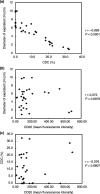Blockade of bulky lymphoma-associated CD55 expression by RNA interference overcomes resistance to complement-dependent cytotoxicity with rituximab
- PMID: 16367924
- PMCID: PMC11158893
- DOI: 10.1111/j.1349-7006.2006.00139.x
Blockade of bulky lymphoma-associated CD55 expression by RNA interference overcomes resistance to complement-dependent cytotoxicity with rituximab
Abstract
Recently, anti-CD20 (rituximab) and anti-Her2/neu (trastuzumab) antibodies have been developed and applied to the treatment of malignant lymphoma and breast cancer, respectively. However, bulky lymphoma is known to be resistant to rituximab therapy, and this needs to be overcome. Fresh lymphoma cells were collected from 30 patients with non-Hodgkin's lymphoma, the expression of CD20 and CD55 was examined by flow cytometry, and complement-dependent cytotoxicity (CDC) assays were carried out. Susceptibility to CDC with rituximab was decreased in a tumor size-dependent manner (r=-0.895, P<0.0001), but not in a CD20-dependent manner (r=-0.076, P=0.6807) using clinical samples. One complement-inhibitory protein, CD55, contributed to bulky lymphoma-related resistance to CDC with rituximab. A decrease in susceptibility to CDC with rituximab was statistically dependent on CD55 expression (r=-0.927, P<0.0001) and the relationship between tumor size and CD55 expression showed a significant positive correlation (r=0.921, P<0.0001) using clinical samples. To overcome the resistance to rituximab by high expression of CD55 in bulky lymphoma masses, small interfering RNA (siRNA) was designed from the DNA sequence corresponding to nucleic acids 1-380 of the CD55 cDNA. Introduction of this siRNA decreased CD55 expression in the breast cancer cell line SK-BR3 and in CD20-positive cells of patients with recurrent lymphoma; resistance to CDC was also inhibited. This observation gives us a novel strategy to suppress bulky disease-related resistance to monoclonal antibody treatment.
(Cancer Sci 2006; 97: 72-79).
Figures





Similar articles
-
Biologic response of B lymphoma cells to anti-CD20 monoclonal antibody rituximab in vitro: CD55 and CD59 regulate complement-mediated cell lysis.Blood. 2000 Jun 15;95(12):3900-8. Blood. 2000. PMID: 10845926
-
Expression of complement inhibitors CD46, CD55, and CD59 on tumor cells does not predict clinical outcome after rituximab treatment in follicular non-Hodgkin lymphoma.Blood. 2001 Sep 1;98(5):1352-7. doi: 10.1182/blood.v98.5.1352. Blood. 2001. PMID: 11520782
-
Downregulation of membrane complement inhibitors CD55 and CD59 by siRNA sensitises uterine serous carcinoma overexpressing Her2/neu to complement and antibody-dependent cell cytotoxicity in vitro: implications for trastuzumab-based immunotherapy.Br J Cancer. 2012 Apr 24;106(9):1543-50. doi: 10.1038/bjc.2012.132. Br J Cancer. 2012. PMID: 22531721 Free PMC article.
-
Rituximab: a review of its use in non-Hodgkin's lymphoma and chronic lymphocytic leukaemia.Drugs. 2003;63(8):803-43. doi: 10.2165/00003495-200363080-00005. Drugs. 2003. PMID: 12662126 Review.
-
[Recent progress in rituximab therapy and its resistance--how do we overcome?].Gan To Kagaku Ryoho. 2007 Aug;34(8):1177-82. Gan To Kagaku Ryoho. 2007. PMID: 17687198 Review. Japanese.
Cited by
-
The Role of Complement in the Mechanism of Action of Therapeutic Anti-Cancer mAbs.Antibodies (Basel). 2020 Oct 28;9(4):58. doi: 10.3390/antib9040058. Antibodies (Basel). 2020. PMID: 33126570 Free PMC article. Review.
-
Anti-Thy-1 Antibody-mediated Complement-dependent Cytotoxicity is Regulated by the Distribution of Antigen, Antibody and Membrane Complement Regulatory Proteins in Rats.J Toxicol Pathol. 2013 Mar;26(1):41-9. doi: 10.1293/tox.26.41. Epub 2013 Apr 22. J Toxicol Pathol. 2013. PMID: 23723567 Free PMC article.
-
Synovial tissue response to rituximab: mechanism of action and identification of biomarkers of response.Ann Rheum Dis. 2008 Jul;67(7):917-25. doi: 10.1136/ard.2007.080960. Epub 2007 Oct 26. Ann Rheum Dis. 2008. PMID: 17965121 Free PMC article. Clinical Trial.
-
Genetic and Epigenetic Modulation of CD20 Expression in B-Cell Malignancies: Molecular Mechanisms and Significance to Rituximab Resistance.J Clin Exp Hematop. 2016;56(2):89-99. doi: 10.3960/jslrt.56.89. J Clin Exp Hematop. 2016. PMID: 27980307 Free PMC article.
-
Immunotherapy for B-cell lymphoma: current status and prospective advances.Front Immunol. 2012 Jan 24;3:3. doi: 10.3389/fimmu.2012.00003. eCollection 2012. Front Immunol. 2012. PMID: 22566889 Free PMC article.
References
-
- Coiffier B. Immunochemotherapy: the new standard in aggressive non‐Hodgkin's lymphoma in the elderly. Semin Oncol 2003; 30 (1 Suppl. 2): 21–7. - PubMed
-
- Tan AR, Swain SM. Ongoing adjuvant trials with trastuzumab in breast cancer. Semin Oncol 2003; 30 (5 Suppl. 16): 54–64. - PubMed
-
- Hiddemann W, Dreyling M, Unterhalt M. Rituximab plus chemotherapy in follicular and mantle cell lymphomas. Semin Oncol 2003; 30 (1 Suppl. 2): 16–20. - PubMed
-
- Dillman RO. Treatment of low‐grade B‐cell lymphoma with the monoclonal antibody rituximab. Semin Oncol 2003; 30: 434–47. - PubMed
-
- Blum KA, Bartlett NL. Antibodies for the treatment of diffuse large cell lymphoma. Semin Oncol 2003; 30: 448–56. - PubMed
Publication types
MeSH terms
Substances
LinkOut - more resources
Full Text Sources
Other Literature Sources
Medical
Research Materials
Miscellaneous

